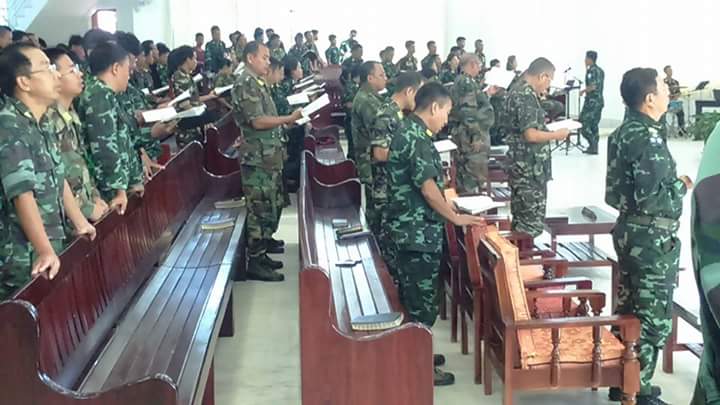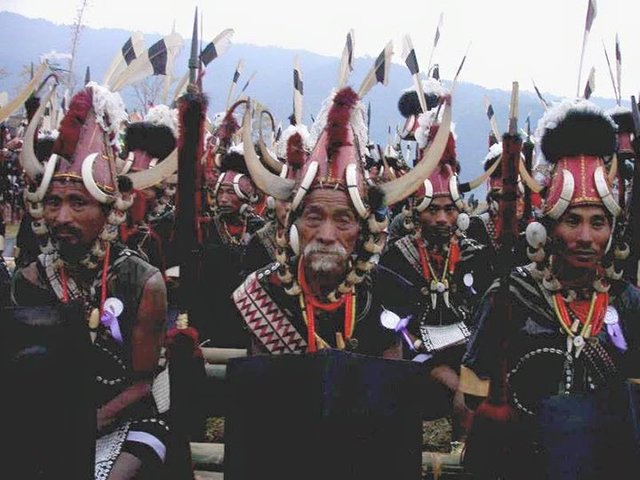indigenousnagaland #4 - A Comparison Between The Colonial Conquest-Resistant Men Of Valor Of India And Nagaland (Indigenous Nagaland)
INDIA'S RESISTANCE TO INVADERS AND INTRUDERS
India: 1
In spreading the idea of self-rule for India, the British activist and writer, Annie Besant, was ahead of India's Mahatma Gandhi himself, who until 1918, was an admirer of the British Empire. Besant founded the Banaras Hindu University, formerly called "Central Hindu School"; she's one of the first persons to demand a self rule for India (she did that even before the end of the 1st world war!), and, in 1915, set up the Home Rule League.
Charles Freer Andrews was a priest of the Church of England, missionary, educator and social reformer, who, with his connection among influential people in England, aroused a sound public opinion for the sake of the colonized people in India, Fiji, South Africa and other such colonies.
By 1906, Andrews had become involved in the activities of the Indian National Congress and helped resolve the 1913 cotton workers’ strike in Madras. It was believed that Andrews was responsible in convincing Gandhi himself to return to India from South Africa, to take part in India's struggle.
Alan Octavian Hume, the British ornithologist and great friend of India, was - in the view of the British - "the founder of the Indian national Congress".
Samuel Evans Stokes Jr. (American) was a signatory to the Congress manifesto in 1921 which called all the Indians to join the National Independence Struggle by giving up on the Government Jobs.
The French socialist Jean Longuet, Karl Marx’s grandson and legal advisor for the Indians, played a contributory role in the Indian Revolutionary Movement in Europe in the initial days.
Major Fujiwara, the Japanese military officer, had helped India in creating the Indian National Army.
Madeleine Slade, born in an aristocratic family in London, left all the luxury and took part in the socio-political struggles in India and promoted Gandhi's Khadi and Satyagraha.
Edmund Kell, Stanley Jones, J.C. Winslow, Varrier Elwin, Ralph Richard Keithahn and Ernest Forrester-Paton are other notable giants (among devout Christians) that espoused for India's freedom.
India: 2
Mohandas Karamchand Gandhi – often known by the honorific “Mahatma”, meaning “great soul” - was a complex figure whose opinions varied wildly throughout his life. Until 1918, he was an admirer of the British Empire and only came to advocate full independence after the Amritsar Massacre of 1919, when Gurkha soldiers under the command of General Reginald Dyer killed at least 379 Indian demonstrators.
Shortly after returning to India from South Africa, he proposed a toast to the British Empire at a dinner of the Madras Bar Association in March 1915, saying: “I discovered the British Empire had certain ideas with which I have fallen in love and one of those ideals is that every subject of the British Empire has the freest scope for his energies and efforts.”
India: 3
On Gandhi, Dr. Susmit Kumar writes,
Although Hitler committed crimes against humanity, I give him credit—and not Gandhi—for India’s independence immediately after World War II. Hitler destroyed the economies of Britain and France to such an extent that they were no longer able to financially maintain their military forces, and were hence incapable of containing the burgeoning freedom movements in their colonies. It is worth noting that Britain was in such bad shape that it received about one-fourth of the total aid given under the Marshall Plan. Regardless of Gandhi or any other charismatic leader, Britain would have left India in 1947 purely for financial reasons, due to its wholly collapsed economy. After WWII, Britain left not only India but nearly all its other holdings, including Jordan in 1946, Palestine in 1947, Sri Lanka in 1948, Myanmar in 1948, Egypt in 1952 and Malaysia in 1957. For the same reason, France also had to grant independence to Laos in 1949 and Cambodia in 1953, and had to leave Vietnam in 1954; Netherlands also left most of its colonies called Dutch East Indies, mainly Indonesia in 1949.
References
"Modernization of Islam and the Creation of a Multipolar World Order," Dr. Susmit Kumar, Ph.D., Booksurge, USA, pp 17-21, 2008
India: 4
Hitler, inspite of his Aryan racial proximity with Indians, had termed the latter of being racially inferior "Asiatic jugglers". In a conference held on March 23,1945, one general raised the question of the Indian Legion, to which Hitler responded:
Hitler: "The Indian Legion is a joke. There are Indians who can't kill a louse, who'd rather let themselves be eaten up. They won't kill an Englishman either. I consider it nonsense to put them opposite the English... If we used Indians to turn prayer mills, or something like that, they would be the most indefatigable soldiers in the world..."
[Source: The Rise and Fall of the Third Reich by William L. Shirer]
Indian revolutionary Subhas Chandra Bose escaped from India on 17 January 1941 and arrived in Berlin via Moscow. There he proposed organizing an Indian national government in exile and urged the Axis to declare their support for the Indian cause.
Bose, with much difficulty, met with Hitler on 29 May 1942. During the discussion, which mostly consisted of Hitler monologuing to Bose, Hitler expressed his scepticism for India's readiness for a rebellion against the British Raj. Hitler, however, promised to financially support Bose and send the latter off to Japan, whose 20,000 troops defeated the 100,000 British, Canadian, Australian, Indian and local Malay troops in Singapore.
References
New Order (Nazism)
Indian Legion
THE NAGA'S RESISTANCE TO INVADERS AND INTRUDERS

[Youngest generation fighters, at Church]

[Warrior attires of the olden days just for remembrance]
In historical records, the first mention of the Nagas as a people inhabiting their present lands was made by Claudius Ptolemy, the Greek historian and geographer in AD 150. In his records Ptolemy mentions the Nagas as Nagaloi (Claudius Ptolemy, Geographia, Vol V11, (ii)p.18). They were again mentioned by Hiuen Tsang, the Chinese traveller who spent 15 years in India between AD 629-645. Hiuen Tsang visited Kamrup the capital of the Varman King, Bhaskar Varman in AD 643. From Kamrup in Assam, in his accounts “Si-Yu-Ki” he writes about the Nagas saying: The east of this country is bounded by a line of hills so that there is no great city to the kingdom. The frontiers are contiguous to the barbarians of Southwest China. These tribes are in fact akin to those of the Man people in their customs.
(Thomas Watters, On Yuan Chwang’s travel in India, Vol.III, Part II, Varanasi, 1903, p.11) Quoted in Visier Sanyü, A History of Nagas and Nagaland, p.7
Naga resistance against intrusions and raids from the kingdoms like the Burmese, Ahom, Manipuri, Tripuri, Dimasha and the Cachar kingdoms from the 13th century to the 18th centuries are all there in recorded history. As for their encounter with the British in the 19th century and their resistance against British rule for one hundred fifteen years (1832 – 1947), numerous accounts are found in the British colonial records.
It is said that the battles the British fought with the Naga tribes in the 19th and first half of the 20th centuries far outnumbered all the frontier battles fought with the Indians in the great Indian sub-continent.
Even in spite of all these battles, the British were able to subjugate only thirty per cent of actual Naga territory. (The actual Naga ancestral domain would be around 120,000 sq. km). In British colonial accounts, the unconquered 70% territories of the Nagas were recorded as unadministered territories or excluded area. Even in the thirty per cent lands that the British administered, they never laid any claims to the lands they were administering. In fact C.V.Aitchinson in Treaties, Engagements and Sanads clearly records that: No written treaties or agreements have been made with any of the Naga tribes. (Vol.XII, 1931, p.91). Also following the submission of the Naga memorandum to the Simon Commission in 1929, where the Nagas had refused to be included in the reformed scheme of India, the British Government in recognition of their demands put the Naga Hills under excluded area in the Government of India Act, 1935.
References
THE FIFTY FOUR-YEAR INDO-NAGA CONFLICT: A QUESTION OF INTERNAL INDIAN ETHNIC CONFLICT OR A CONFLICT BETWEEN TWO NATIONS -Part II
CONCLUSION
The vastness of wealth in India coupled with India's less than greatest resistance, to the British invaders, had made India the most attractive destination with the greatest "return of investment" for the British empire, bar none.
The British, with less than 34,000 British troops (of all ranks), had ruled over India's 257,000 Indian troops for 200 years.
However, in the case of Nagas, the British invaders came into conflict with the fiercest resistance (according to the British sources) with no similar "return of investment" as in India, except for the land's strategic location. So the British neither push too deep into the land nor did they impose a direct rule, and nor was a written agreement or treaty made, in the case of Nagas.
Without much of a surprise, the Indo-Naga-Myanmar war, which began after the British departure, has now become one of the world's longest-running wars of our time whose end is still nowhere in sight!
@minnowpond1 has voted on behalf of @minnowpond. If you would like to recieve upvotes from minnowponds team on all your posts, simply FOLLOW @minnowpond.
This post received a 4.66% upvote from @randowhale thanks to @truthtellerhere! To learn more, check out @randowhale 101 - Everything You Need to Know!
This wonderful post has received a bellyrub 1.53 % upvote from @bellyrub thanks to this cool cat: @truthtellerhere. My pops @zeartul is one of your top steemit witness, if you like my bellyrubs please go vote for him, if you love what he is doing vote for this comment as well.
This post has received a 0.32 % upvote from @booster thanks to: @truthtellerhere.